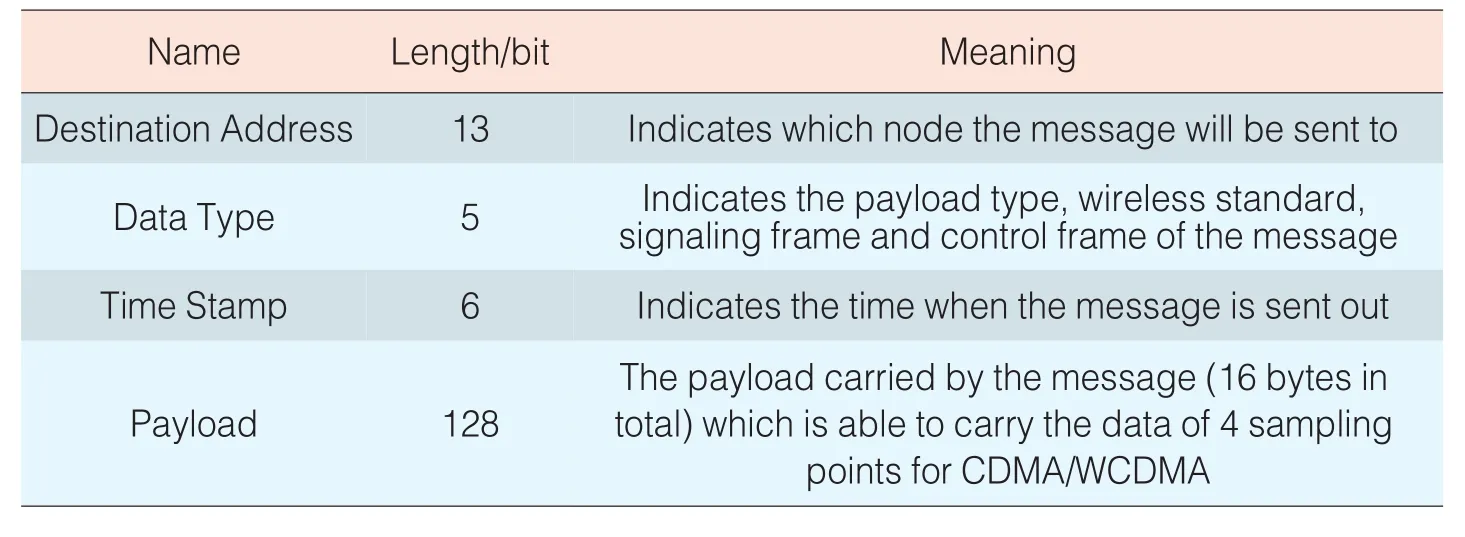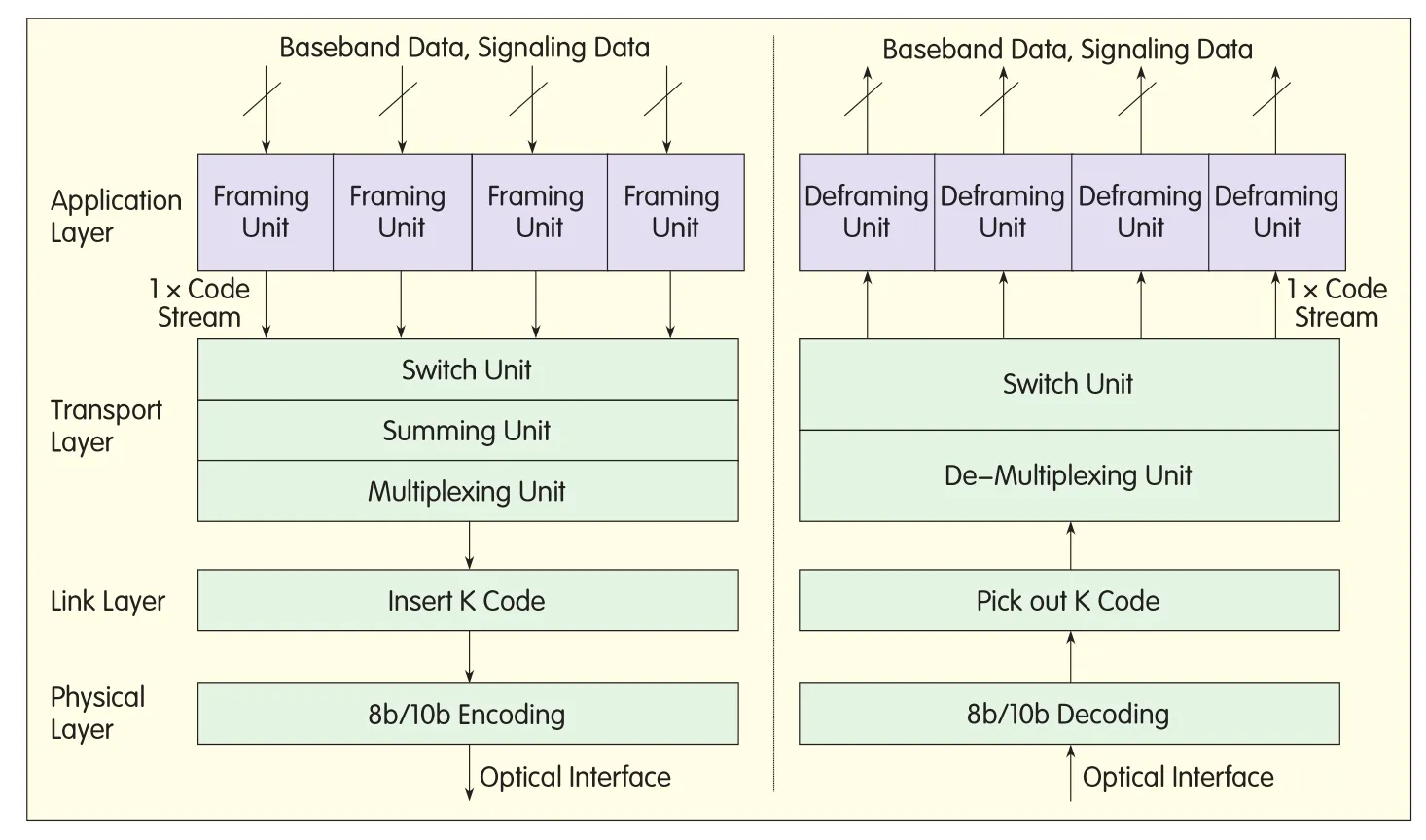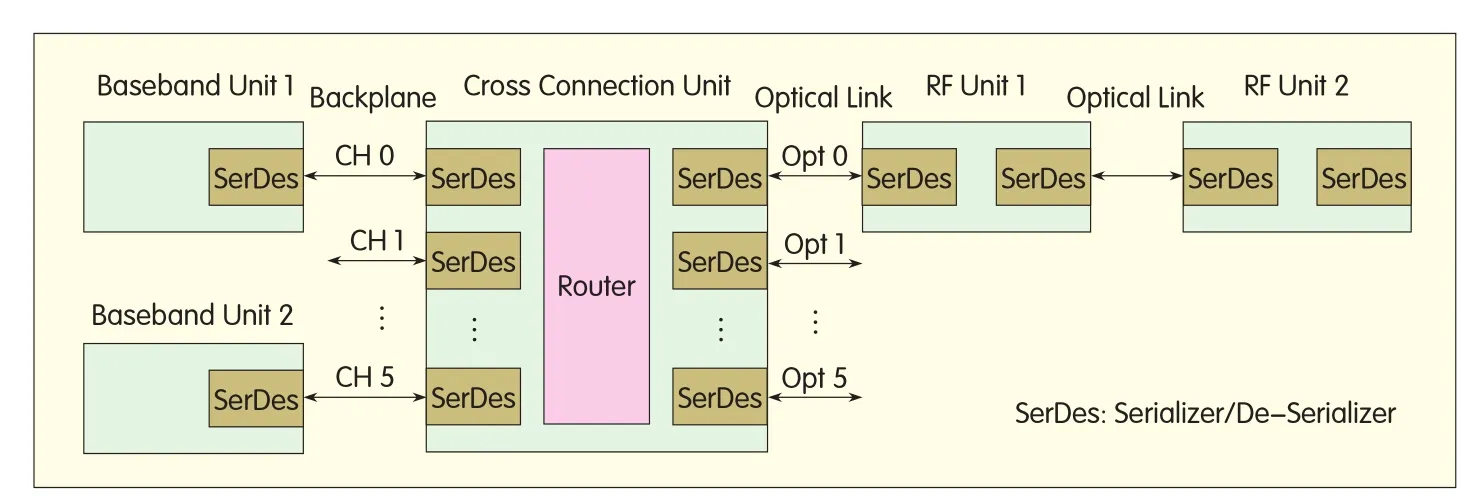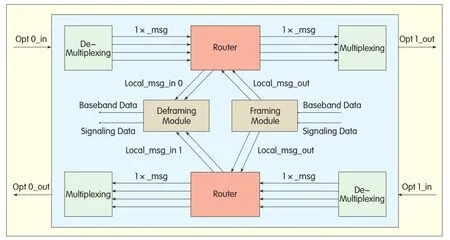Using OBSAI to Build the Baseband-RF Interface of Multi-Mode Base Stations
2010-09-08
(ZTE Corporation,Shenzhen 518004,P.R.China)
Originally,3G standards included Wideband Code Division Multiple Access(WCDMA),CDMA2000,and Time Division Synchronous Code Division Multiple Access(TD-SCDMA).A fourth,Worldwide Interoperability for Microwave Access(WiMAX),appeared in 2007.Together with 2G standards and the Long Term Evolution(LTE)standard,a total of seven wireless standards currently exist in the telecommunications industry.This places a burden on equipment vendors.If standards can be integrated on one hardware platform(the multi-mode base station),R&D and device expenditure of equipment vendors will be substantially reduced.
As its name implies,a multi-mode base station is able to support several different wireless standards.Because multi-mode base stations cut down hardware costs and make it easy for operators to launch new services,vendors are now developing them in the hope of winning an upper hand in future competition.
One of the problems in developing multi-mode base stations,however,is the baseband-RF interface.The interface is a data transport link between the BBU and RF,and contains auxiliary information—such as signaling and timing—that cannot be easily integrated for transmission.This is because the data format and rate varies from standard to standard.
The two most commonly used baseband-RF interface standards are the Common Public Radio Interface(CPRI)and the Open Base Station Architecture Interface(OBSAI).The frame structure and layered design of OBSAI is particularly suitable for simultaneous transmission of baseband data of different wireless standards.[1]Although CPRI also allows for such transmission,the individual data frames are too large and must be split into smaller blocks.Moreover,since the rate of baseband data and size of data blocks varies according to different wireless standards,CPRI cannot be easily applied.It is therefore necessary to use OBSAI as the standard for the baseband-RF interface in a multi-mode base station.
1 Brief Introduction of OBSAI Protocol
The OBSAI is a standardization organization established by Nokia,ZTE,LG,Hyundai,and Samsung.It aims to create a public interface between the BBU and RF so that devices of different vendors can be interconnected.
The minimum unit of the OBSAI standard is a message of 19 bytes,which includes the destination address,data type,time stamp,and payload.Table 1 details the length and meaning of each part of the message.
The OBSAI standard divides the baseband-RF interface into 4 layers from the top down:the application layer,transport layer,link layer,and physical layer.During transmission,the application layer inserts baseband data and signaling data into the message;the transport layer cross-connects,sums up,multiplexes,and combines the message data streams into one channel;the link layer inserts regular special code into the data stream for marking the good/bad status of the link;and the physical layer performs 8b/10b encoding and decoding,serial-to-parallel conversion,and serial transmission.During reception,this process is reversed.Every layer transmits data that it extracts to the upper layer,and finally the baseband data and signaling data are extracted.The summing step occurs during transmission but not at reception.It is also necessary for CDMA/WCDMA,but not WiMAX.Figure 1 shows the structure of the whole standard.

Table 1.Length and meaning of every part of an OBSAI standard message

Figure 1.Structure of OBSAI protocol.
Both the BBU and RF have 4 layers because they need to extract the baseband data.However,only the bottom 3 layers need data extraction.
The OBSAI standard sets down 3 optical fiber rates:768 Mbit/s,1,536 Mbit/s and 3,072 Mbit/s(usually referred to as 1x,2x,and 4x).Two 1x data streams can be converged into one 2x data stream through message cross-connection multiplexing,and likewise two 2x data streams can be converged into one 4x data stream.Because the 1x data stream has a low rate and is convenient for processing,the 2x and 4x data streams are usually de-multiplexed into several 1x data streams,processed,and then finally multiplexed back into 2x and 4x data streams.
An optimal module comes with several fixed rates including 1.25 Gbit/s,2.5 Gbit/s,and 3.125 Gbit/s.This is why the three rates of OBSAI should be fixed at these values.However,since they are not,there is some bandwidth waste,and the transmission efficiency of OBSAI is comparatively low.CPRI has high transmission efficiency because its rates are well matched to those of the optical module.In R&D,the parameters may be adjusted so that OBSAI can work at the same rates as CPRI while the interior structure remains unchanged.
2 Principles of the OBSAI-Based Baseband-RF Interface
Connection between the separated BBU and RU can occur in 2 ways:the BBU may connect with the RF by itself through the optical interfacer,or several BBUs may send their own data to the cross-connection unit for summing and then connect with the RF through the optical interface.If data of different standards is to be sent through one optical fiber,then only the second way can be adopted.Only using the second way can the various baseband data be mixed together.Figure 2 depicts the two types of connection,where optical fiber may also be replaced by high-rate cable.
A multi-mode base station will most likely adopt the second way of connecting for the sake of resource sharing and easy cabling.The rationale of OBSAI baseband-RF interface will now be examined using the second way of connecting.
One BBU supports several sectors.Each sector has the same data rate and format but the rate and format of baseband data varies with different wireless standards.To use the same transport link for varying baseband data,the baseband data cannot be transmitted in its original format;instead,it must be encapsulated in one container.An OBSAI message may serve as such a container for storing baseband data of different standards.Every message works individually and allows for any switch and forwarding,independent of the wireless standard.

Figure 2.Two ways of connecting the BBU and RF in a base station with separate BBU and RF.

Figure 3.Structure of a OBSAI-based multi-mode base station.
As far as CDMA and WCDMA are concerned,baseband data also requires the summing process;that is,summing up the data sent by several BBUs to the same sector and then sending the result to the RF.Thus,more baseband processing resource of the sector is available,and resource sharing and dynamic allocation of resources is possible.Summing was once performed directly on original baseband data,which is suitable if only one wireless standard is involved.When several standards are involved,however,it is very difficult to pick data of the same standard and accommodate data of different rates.The problem can be solved if all baseband data is carried in an OBSAI message.The OBSAI standard comes with a message summing function;summing is performed on messages with exactly the same destination address and data type,and only the payload is summed up while the address and type remain the same.Since one message can carry data of 4 sampling points,and the format of the messages is uniform,the result of the messages summing is identical to that done directly on original data.In other words,it is not necessary to extract the payload before summing,and this makes the design of switch unit much simpler.
As for the RF,when an optical fiber carries data of different standards,the payload is traditionally extracted first before being forwarded as required by the configuration.As long as the payload is extracted,its relevance with wireless standard cannot be ignored.And once the standard changes,the corresponding functional module should also be changed.This is unconducive to stable product versions.With the OBSAI standard,the payload need not be extracted;instead,whether the message is forwarded or not is determined by the destination address,not the payload.Only those messages sent to a local address should have their payload(baseband data)extracted and sent to mid-frequency and RF processing modules.The local unit will not be affected even if the RF of other wireless standards are involved later.This gives rise to much better version stability.
3 Block Diagram of OBSAI-Based Multi-Mode Base Stations
Figure 3 shows the structure of a multi-mode base station built with the OBSAI standard.
In Figure 3,BBUs 1 and 2 support different wireless standards.Suppose CDMA is used for BBU 1 and WCDMA for BBU 2,and RFs 1 and 2 correspond to BBU 1 and 2 respectively.Two BBUs separately adapt their own baseband data into the OBSAI data stream and forward it to the switch unit.The rate of the path matches that of the baseband data,but the rates of paths need not be the same.Figure 4 shows the logic diagram of the BBU(those below the link layer are omitted).
In Figure 4,the framing module adapts the baseband data and signaling data into the 1x OBSAI data stream.At most,there are four channels of 1x data streams sent to the multiplexing module.The multiplexing module combines(in the sequence of message switch)the four data streams into a single 4x data stream.If the baseband data does not use the 4x data stream,the first two framing modules are enough.The multiplexing module converges the two 1x data streams into a 2x data stream in order to make flexible use of the rates.
The OBSAI logic diagrams of all BBUs are the same.The framing modules,however,are different because they are closely related to the wireless standard of the baseband data.The CDMA and WCDMA standards are quite similar in that the data of the sectors is sent in at the same time and in the same data format.The rates of data are different,and therefore they have the same method of framing(reading the data of four sampling points of every sector by turn,and inserting them into one message).The format of WiMAX baseband data is noticably different,as the data of each sector is sent in turn—each being one sign wide.Therefore,the OBSAI reads data of the first sector first,and data of the second sector next.Such a reading sequence requires only a First-In First-Out(FIFO)queue to be added to the design.WiMAX equipment manufactured by ZTE has an OBSAI module designed in this way.
It is notable that in the framing module,the destination address of baseband data is added to the header of every message.The destination address can be worked out according to the sector number and it is useful for switch and forwarding by downstream units.

Figure 4.Logic diagram of the baseband unit.

Figure 5.Logic diagram of the switch unit.
A standard OBSAI data stream reaches the switch unit.The switch unit is a public module where the baseband data of all wireless standards are cross-connected and summed up before they are forwarded to a related optical interface.This unit should be unrelated to the wireless standard so that it can support different standards.Figure 5 shows the logic diagram of the switch unit.
As shown in Figure 5,CH0-CH5 are the data streams(4x rate employed)coming from six BBUs.These data streams run through the De-Multiplexing module first where they are broken into four 1x data streams.Next,the router module routes the data streams to different optical interfaces according to information given in the Message Header,and every optical interface accepts four 1x data streams(at most).Finally,the multiplexing module combines the data streams into one data stream and sends it out through the optical fiber.
The switch unit only employs the bottom three layers of the OBSAI,not the application layer.Therefore,it is insensitive to the format of the payload data.Baseband data of different standards can all be routed through the same switch unit and then forwarded to related optical interfaces.They can be mixed in one optical link for transmission,and the downstream units will know from the destination address whether to send the message to local destinations or forward it on.
The RF receives the OBSAI data streams from the optical interface,breaks them into several 1x data streams using the De-Multiplexing module,and determines where they will go using the routing module.The streams may go to the local application layer for extracting the baseband data(if the destination address is a local one),or to downstream units(if the destination address is not a local one).The data stream sent from the local unit also comprises several 1x data streams.These are sent to two optical interfaces at the same time and then multiplexed together with the forwarded data streams onto one link before being sent out.Figure 5.shows the block diagram of the module with 4x optical interface.

Figure 6.Logic diagram of the RF unit.
To make the logic design simpler,a 1x data stream can be divided into a maximum of two 0.5x data streams.One RF can take up at least one 0.5x data stream,and one optical link can support a concatenation of eight RFs(at most).
In Figure 6,only the framing and deframing modules are closely related to the wireless standard while other modules are public ones and are exactly the same.Therefore,devices can be developed much faster to support new standards.
4 Conclusions
When building the interface between the BBU and RF of a multi-mode base-station using OBSAI,the BBU and radio unit must be changed to support the new wireless standard.If the optical interface rate remains the same,changing other software,hardware,or logic within the units is unnecessary.The bottom transport modules of the BBU and RF module are the same;existing modules can be used so that R&D can focus on the wireless standard.
The biggest drawback of using OBSAI is the low transmission efficiency due to high overhead.This is why the OBSAI standard is used less than CPRI.However,the layered structure of OBSAI can effectively screen out the impact of wireless standards so that different standards are supported on one hardware platform with a single optical fiber.This makes OBSAI a valuable standard for multi-mode base stations.
Reference
[1]OBSAI reference point 3 specification[R].OBSAI SIG,2005.
